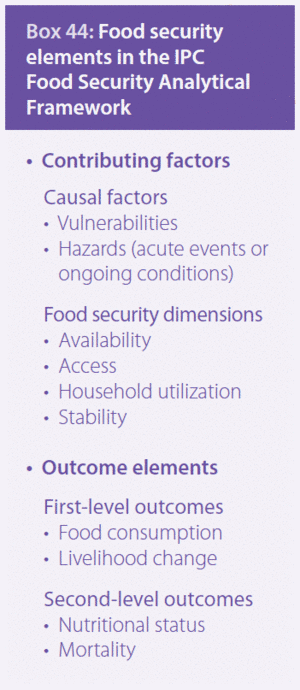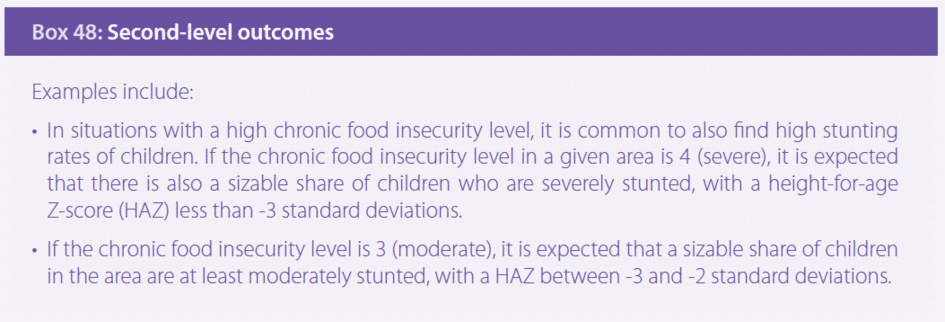
Protocol 2.1: Use Analytical Framework to guide convergence of evidence
The purpose of the IPC Food Security Analytical Framework (Box 44) is to guide convergence of evidence through a logical outline of food insecurity. The Framework is divided into contributing factors and outcomes. Contributing factors include drivers and dimensions of food insecurity and outcomes include the expected manifestation of food insecurity at the household and individual levels (Figure 7).
Contributing factors
Causal factors: vulnerabilities and hazards (acute events or ongoing conditions)
According to the IPC, the interaction between recurrent shocks/ongoing conditions and vulnerabilities drives food insecurity. Thus, analysis of these interactions identifies the “key drivers of food insecurity” (Box 45). Vulnerability is defined as the household’s exposure, susceptibility and resilience to specific recurrent hazards.
According to the IPC, analysis of vulnerability is mainly driven by an understanding of households’ livelihood strategies (how they obtain food and income; how sustainable the food and income sources are; what the expenditure patterns are); their livelihood assets (financial, physical, human, social and natural assets); and how policies, institutions and processes, gender and mitigating factors positively or negatively affect, or could affect, the households and their ability to achieve food security and to cope with the different recurrent acute events or ongoing conditions. Recurrent acute events or ongoing conditions can be natural or human-made, including recurrent droughts or floods or other natural phenomena, price volatility, energy or food shortages, civil unrest, HIV/AIDS or other diseases, generalized poverty, and other conditions that can impact on food security.
The concept of resilience is explicitly included in the IPC Food Security Analytical Framework, since it is acknowledged as a factor that, together with exposure and susceptibility, determines the vulnerability of households to specific recurrent acute events and ongoing conditions. Consideration of resilience is ensured through an examination of livelihood strategies, assets and policies, institutions, and processes. IPC analyses can contribute to and benefit from more comprehensive analyses of resilience.
Four security dimensions: Availability, access, household utilization and stability
The four food security dimensions (food availability, access, utilization and stability) will be directly impacted by the interactions between the recurrent acute events/ongoing conditions and the vulnerabilities. It is important to carry out an analysis of how each of the dimensions limits food security in order to confirm and contextualize outcome indicators, and their presentation to decision-makers enables them to better design interventions with a more strategic focus on availability, access, utilization or stability (Box 46). These dimensions interact in a sequential manner: food must be available; households must have access to it; they must utilize it appropriately; and the whole system must be stable. Food availability addresses whether food is actually or potentially physically present for purchase or consumption, including aspects of production, food reserves, markets and transportation, and wild foods. Once the availability of food has been analysed and understood, the next question is how households access it through different food sources (e.g. own production, purchases, gifts, aid, gathering) and whether they will be able to acquire enough food to cover their needs from the sources available. The ability to access enough food will directly depend on physical access (e.g. own production, distance to markets), financial access (e.g. purchasing power, access to credit) and social access (e.g. ethnicity, religion, political affiliation). If food is available and households have adequate access to it, the next question is whether they are able to consume the accessible food that provide the adequate quantities of nutrients and energy, usually a factor of, inter alia, food preferences, preparation, storage, and access to improved water sources. If the dimensions of availability, access and utilization are sufficiently met so that households have adequate quality and quantity of food, the next question is whether the whole system is stable, thus ensuring that the households are food-secure at all times. Stability problems can refer to short-term instability, which can lead to recurrent acute food insecurity, or medium-/long-term instability, which can lead to chronic food insecurity. Climatic, economic, social and political factors can all be a source of instability.
First-level outcomes: Food consumption and livelihood change
If food availability, access, utilization and stability are not adequate, then household consumption is likely to be inadequate. The severity of the inadequacy of food consumption is dependent on how inadequate one or more elements are and how well households are able to adapt to the situation. In the IPC Chronic Food Insecurity analysis the adequacy of both the micronutrient and energy intake is assessed, whereas in the IPC Acute Food Insecurity analysis, the focus is on the adequacy of energy intake (Box 47).
If households have difficulties in securing enough food, they may engage in unsustainable strategies, such as selling assets, decreasing expenses in education and health, and consuming seeds. In situations of chronic food insecurity, however, the presence of severe livelihood coping behaviour such as selling homes or land because of food insecurity is very rare, and even other negative livelihood coping behaviours are not common over a long period of time. As a result, livelihood change outcome is not analysed in the IPC Chronic Food Insecurity analysis; rather, the sustainability and strength of household livelihoods are analysed, by focusing on assessing the share of households that employ low-value livelihood strategies, i.e. strategies that yield either little or unstable income that is insufficient to cover the basic needs of a household in terms of food consumption, education and health expenses.
Second-level outcomes: Nutritional status and mortality
The focus is on chronic malnutrition, which is measured by the height-for-age Z-score (HAZ) and is estimated at the area level by the prevalence of children 6–59 months with a HAZ less than -2 standard deviations, referred to as prevalence of stunting (Box 48). It is generally agreed that stunting is caused by poor diets (quantity and quality of consumption) and morbidity, which in turn are a product of inadequate caring and feeding practices, and inadequate health services and environmental health, together with food security factors. Given that many of the root causes of chronic food insecurity and chronic malnutrition are the same, it is expected that prevalence of chronic malnutrition informs the analysis of the chronic food insecurity situation to a certain extent.
Mortality as an outcome is not analysed in the IPC analysis. Whereas it is known that malnutrition contributes to around half (45 percent) of the deaths of children under 5 globally (WHO, Children: Reducing mortality. Fact Sheet, updated in October 2017. www.who.int/mediacentre/factsheets/fs178/en), the use of death rates to support classification of chronic food insecurity is not included for two main reasons. First, death rates are expected to remain at a stable and relatively low level (typically a CDR at or below 0.5 per 10,000 daily and a U5DR at or below 1 per 10,000 daily) in chronic situations, making it less useful for differentiation of severity. In addition, since the mortality indicators are expressed as rates rather than as prevalence, unlike the other indicators included in the Reference Table, their usefulness is further decreased since they do not inform the distribution of populations among the four levels.
